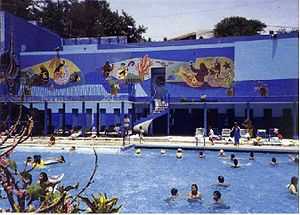Agua Hedionda Spa
The Spa of Agua Hedionda (Spanish: "Balneario de Agua Hedionda") is a mineral spring - day spa located in the city of Cuautla, in the state of Morelos, Mexico, about 60 miles (97 km) south of Mexico City.
Agua Hedionda means in Spanish "Foul Smelling Water", and it is also the name of the residential neighborhood that surrounds the spa, with approximately 10,000 inhabitants.
The name was probably given because the waters have a characteristic smell that reminds one of "rotten eggs", due to the presence of sulfur. In fact, the content of minerals in Agua Hedionda's waters classifies it as one of the important spring waters in the world. The smell however, is by no means repugnant.

The Spa
The waters originate from the melting snows of the Popocatepetl and Ixtaccihuatl volcanoes. It is probable that the spring was visited since antiquity by the Olmecs, the Teotihuacans, the Chalca tribe, the Tlahuica tribe, and the Aztecs. All these resided in this area at one time or another.
The first chemical analysis of the waters were made in the late 19th century and the current spa premises of Agua Hedionda were built by the Mexican government in 1928.
Besides its waters and the weather (sub-tropical), the outlay of Agua Hedionda makes it a popular tourist attraction: the grounds are surrounded by ancient trees and gardens, where all types of birds can be seen and heard. There are 2 large swimming pools (240 x 60 feet (18 m) and 120 x 60 feet) in which the water constantly flows, 8 small pools that can be rented for private use, a restaurant, a convenience store, and locked cubicles for the changing of clothes. It is open 365 days a year.
Due to the purity, transparency, and amount of chemical elements in its waters, Agua Hedionda is internationally recognized as one of the top mineral spas. The water is not warm (about 80-82^ F) and the spring's output surpasses 200 gallons per second.
Medical Properties
Agua Hedionda's water is not only rich in sulfur, but the "decay" of its minerals results in radioactivity. In this regard, Agua Hedionda occupies second place in the world, but as a spa, the first (see below). Therefore, it is considered to be an important source of mineral-therapy, as sulfured waters are thought to be beneficial for ailments of the skin, and the respiratory and locomotive systems. Similarly, it is empirically agreed that radioactive waters have sedating and analgesic effects, and are also helpful in combating stress, anxiety and depression .
Water's Radioactivity
Comparative analysis of the radioactivity of Agua Hedionda's water:
- - Brombach, Germany--------- 805,000 cubic nanograms (Closed to the public).
- - AGUA HEDIONDA, MEXICO ----- 783,000 cubic nanograms
- - Joachimsthal, Czech Republic---- 240,000 cubic nanograms
- - Valdemorillo, Spain------- 219,000 cubic nanograms
- - Ischia, Italy--------- 198,000 cubic nanograms
- - Gastein, Austria---------- 81,000 cubic nanograms
- - Jerez, Spain-------------- 62,000 cubic nanograms
- - Luchon, France------------ 48,000 cubic nanograms
- - Luso, Portugal------------- 34,000 cubic nanograms
Water's chemical analysis*
- pH:6.45
- Volatile Solids: 51.30 PPM
- Fixed Solids: 2017 PPM
- Total Solids:2530 PPM
- Calcium: 521 PPM
- Magnesium: 26.1 PPM
- Sodium: 72.1 PPM
- Chlorides: 98.6 PPM
- Sulfates: 1059.6 PPM
- Sulfhidric Acid: Trace
(PPM= parts per million)
(*source: National University of Mexico)